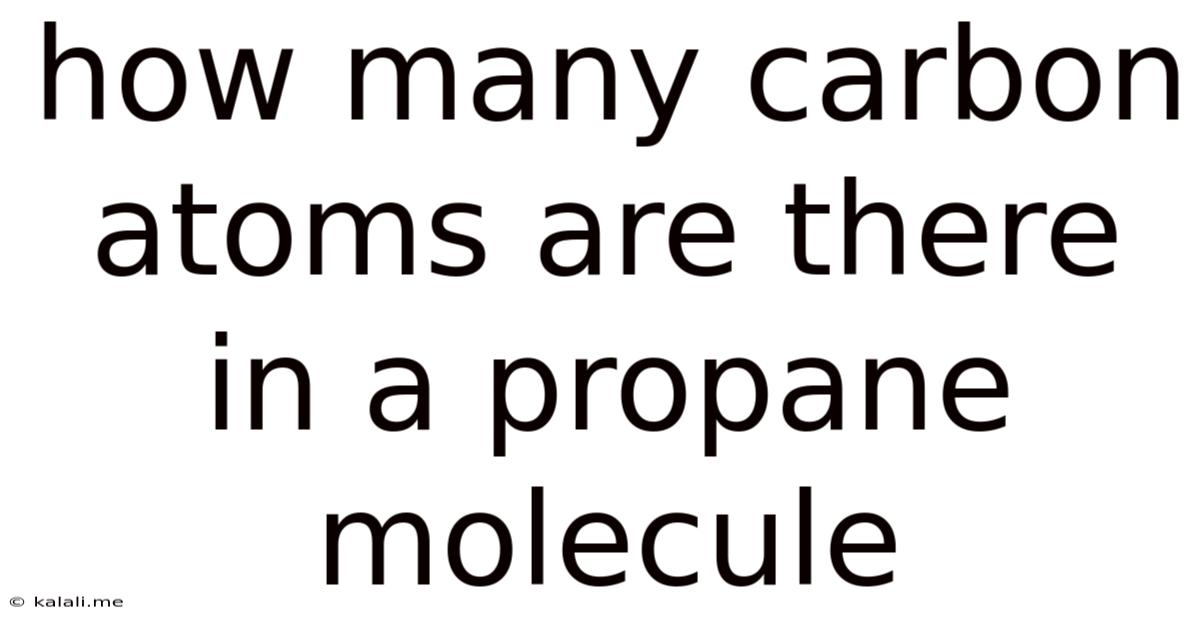How Many Carbon Atoms Are There In A Propane Molecule
Kalali
Jun 11, 2025 · 3 min read

Table of Contents
How Many Carbon Atoms are There in a Propane Molecule? A Simple Explanation
Meta Description: Learn the simple answer to the question: how many carbon atoms are in a propane molecule? This article explains propane's chemical structure and its relevance.
Propane is a common fuel source used in many applications, from heating homes to powering vehicles. Understanding its chemical structure, particularly the number of carbon atoms, is fundamental to grasping its properties and uses. So, how many carbon atoms are in a propane molecule? The answer is three.
Understanding the Propane Molecule (C₃H₈)
Propane's chemical formula, C₃H₈, tells us everything we need to know. Let's break it down:
- C₃: This part represents three carbon atoms. These carbon atoms are the backbone of the propane molecule. They are linked together in a chain.
- H₈: This indicates eight hydrogen atoms. These hydrogen atoms are bonded to the carbon atoms, completing the molecule's structure.
The arrangement of these atoms is crucial. The three carbon atoms form a straight chain, with each carbon atom bonded to its neighbor. The hydrogen atoms are then bonded to the carbon atoms, filling the remaining valency. This specific arrangement contributes to propane's properties, such as its flammability and its gaseous state at room temperature and normal atmospheric pressure.
Why is Knowing the Number of Carbon Atoms Important?
Understanding the number of carbon atoms in a molecule like propane is crucial for several reasons:
- Chemical Reactions: The number of carbon atoms directly influences how the molecule will react with other substances. This is essential in understanding combustion (burning), a process central to propane's use as a fuel.
- Physical Properties: The structure and the number of carbon atoms affect propane's physical properties, including its boiling point, melting point, and density. These properties determine how propane can be stored, transported, and used safely.
- Isomerism: Although propane only has one structural isomer (meaning it exists in only one arrangement of atoms), other alkanes (hydrocarbons with single carbon-carbon bonds) with more carbon atoms can have multiple isomers, leading to varied properties. Knowing the number of carbon atoms helps in predicting the possibility of isomers.
- Organic Chemistry Fundamentals: This seemingly simple question serves as a building block for understanding more complex organic molecules and their chemical behavior.
Beyond Propane: Exploring Other Alkanes
Propane is a member of the alkane family, which are hydrocarbons with only single bonds between carbon atoms. Other alkanes, like methane (CH₄), ethane (C₂H₆), butane (C₄H₁₀), and pentane (C₅H₁₂) follow a similar pattern, with the number of carbon atoms determining their chemical formula and properties. Each alkane in this homologous series increases by one carbon and two hydrogen atoms.
In conclusion, the propane molecule contains three carbon atoms. This seemingly simple fact is fundamental to understanding its chemical behavior, physical properties, and its widespread use as a fuel. Understanding the structure of molecules like propane provides a foundation for comprehending more complex organic chemistry concepts.
Latest Posts
Latest Posts
-
How Many Quarters Are In An Ounce
Jul 01, 2025
-
How Many Times Does 11 Go Into 40
Jul 01, 2025
-
Elvis Presley Gospel One Pair Of Hands
Jul 01, 2025
-
What Is The Fine For Killing A Buzzard
Jul 01, 2025
-
How Old Am I If I Was Born In 1996
Jul 01, 2025
Related Post
Thank you for visiting our website which covers about How Many Carbon Atoms Are There In A Propane Molecule . We hope the information provided has been useful to you. Feel free to contact us if you have any questions or need further assistance. See you next time and don't miss to bookmark.